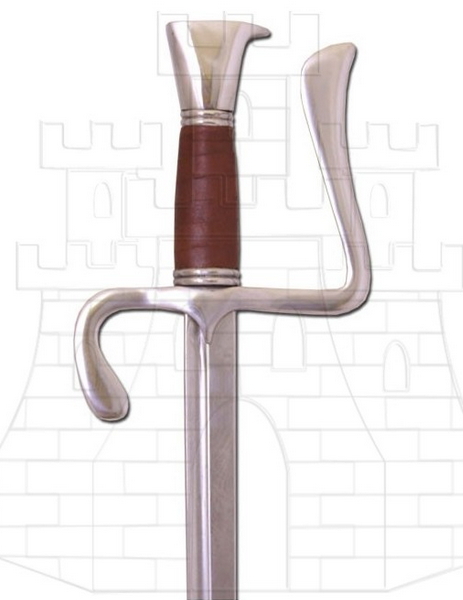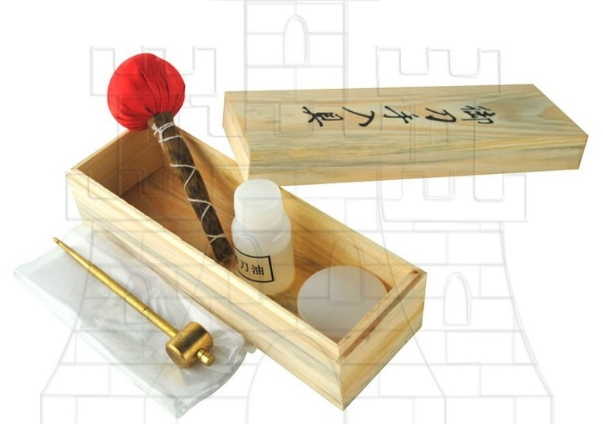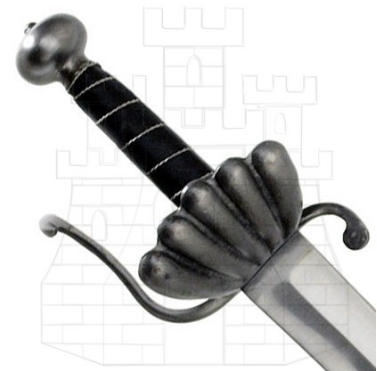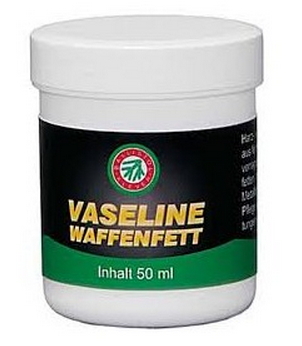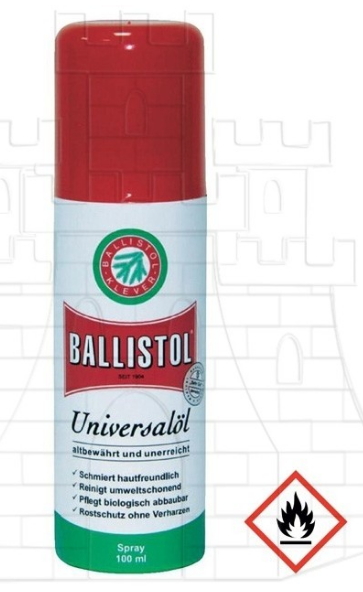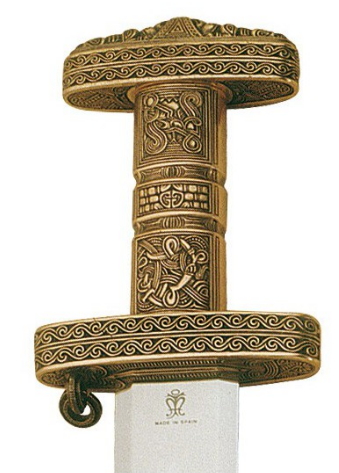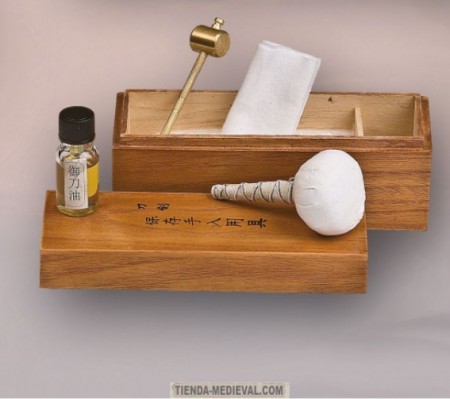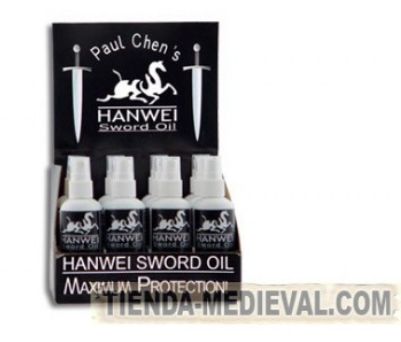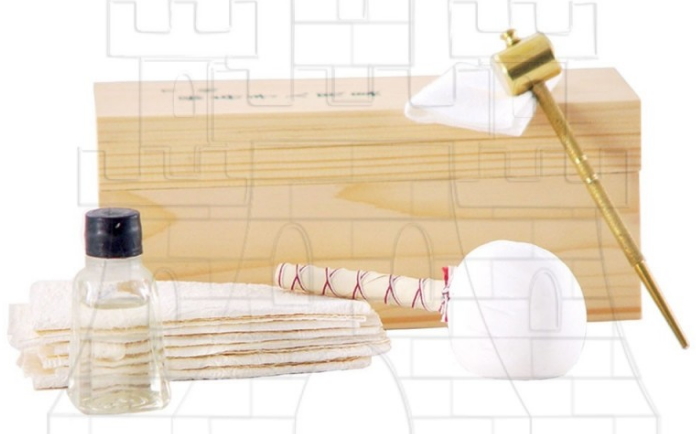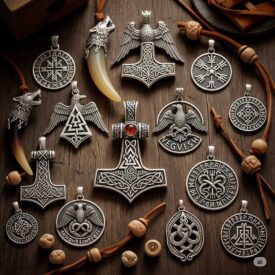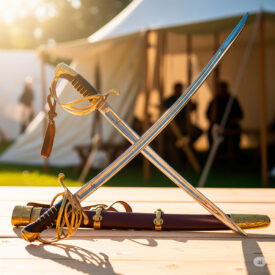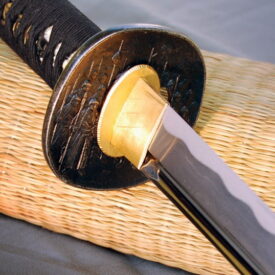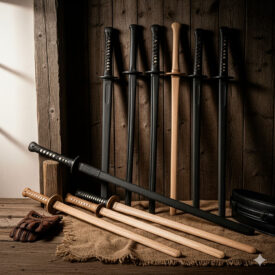Swords, sabers, and rapiers are much more than simple objects; they are fascinating witnesses to past eras, pieces of craftsmanship, and, in many cases, valuable fragments of history. Maintaining their splendor and functionality is a responsibility for collectors and enthusiasts. However, time, humidity, and oxygen are relentless enemies, and rust is the main threat. Fortunately, with the right approach and a little patience, you can combat this deterioration and ensure your blade endures for generations.
First, it is essential to remember that any cleaning of a sword blade is a task that should be carried out by an expert, especially when dealing with valuable and ancient pieces. It is not a matter for amateurs, nor for improvisations. Furthermore, it is normal for time to age a sword, which is positive, as it can make it more beautiful and valuable.
Understanding the Enemy: What is Rust?
Scientifically, rust is an iron oxide (Fe₂O₃) that forms through a chemical process called oxidation. This occurs when iron reacts with oxygen in the presence of water or environmental humidity. Since steel is an alloy containing iron, steel blades are also susceptible to oxidation.
There are mainly two types of rust that affect bladed weapons:
- Surface rust: Appears as reddish-brown discolorations on the surface and is usually easy to remove.
- Deep rust: These are dark brown to black spots that penetrate deeper into the metal, potentially leaving pitting and, if left untreated, permanently corroding the blade.
Steel is basically an alloy or combination of iron and carbon (around 0.05% up to less than 2%). Sometimes other specific alloying elements such as Cr (Chromium) or Ni (Nickel) are added.
Pure iron is one of the elements of steel, so it is not found free in nature and chemically reacts with oxygen in the air to form iron oxide – rust.
Types of Steel and their Rust Resistance
Different types of steel are classified according to the alloying elements that produce distinct effects on the steel:
- CARBON STEELS: More than 90% of all steels are carbon steels. These steels contain various amounts of carbon and less than 1.65% manganese, 0.60% silicon, and 0.60% copper. They are more susceptible to oxidation.
- ALLOY STEELS: These steels contain a determined proportion of vanadium, molybdenum, and other elements, in addition to larger amounts of manganese, silicon, and copper than normal carbon steels. Their rust resistance varies according to the alloy.
- STAINLESS STEELS: Stainless steels contain chromium, nickel, and other alloying elements, which keep them bright, hard, and resistant to rust and oxidation despite the action of humidity. Although they are “stainless,” they are not immune to rust under certain extreme conditions, but they are much more resistant.
The Philosophy of Restoration: Preserving History, Not Erasing It
This is where a crucial consideration comes in, especially with historical pieces: the difference between “restoring” and “preserving.” This article does not deal with restoration in the most aggressive sense, but with conservation. We will not talk about the conservation of ancient swords from excavations or shipwrecks, nor special swords with gold-decorated or blued blades, nor fire-gilded hilts or those with special decorative treatments (nickel plating), nor Damascus steel blades, nor Oriental blades from the Japanese tradition.
With ancient weapons, trying to return them to a “fresh out of the factory” look is a mistake that can destroy their value. A historical object is valued precisely for its age and the “scars” that tell its story.
Cases like ancient coins stripped with acid, which destroyed their patina and value, or a historical dagger polished until it looked new, are examples of how excessive “restoration” can actually be destruction. Patina, that dark superficial layer of magnetite that forms on forged artifacts, is desirable and should not be removed. A blade with dark, matte areas is preferable to a shiny one with sanding or power brush marks.
In the field of technical antiques, such as cars, it is more accepted to restore them to a new appearance. However, in the world of antique bladed weapons, the objective is not to use the sword for its original function (we will not sharpen it for display or fencing practice if it is a museum piece), but to preserve its historical value.
Therefore, the motto is “less is more.” Whenever it is a piece of historical value, it is recommended to be restrained, remove active rust and stabilize it, without overdoing it with the old patina. Documenting each intervention is fundamental to respecting the object’s history. If it is a museum piece or of great value, it is ideal to consult an expert.
It is up to the reader’s sound judgment to decide how to best preserve their sword, choosing the most convenient method. The first step to properly preserving a sword is adequate cleaning. The removal of active reddish rust and old, already stabilized dark and very hard rust is something that should be objectively valued, because it can be a reflection of an antiquity that provides the true value of the sword.
Practical Methods for Removing Rust
Before starting, it is essential to take precautions:
- Work on a stable, clean surface, preferably with a soft towel.
- Wear gloves to avoid fingerprints and protect yourself from sharp edges.
- Make sure you have good lighting to detect even the smallest dirt or rust.
- Always test any method on a discreet area of the blade to see how the metal reacts.
1. For Light Surface Rust: Gentle and Non-Abrasive Methods
These methods are ideal for rust that has just started to form and aim to be as non-invasive as possible to preserve the original surface. They are perfect for regular maintenance and to prevent rust from progressing.
- Oil and very fine steel wool (0000): Dip the steel wool in synthetic engine oil or a gun lubricating oil and rub with light pressure and plenty of oil. The rust will come off without damaging the steel and will leave a protective layer. This method also works with lemon juice. The most recommended method is the use of “00” or “000” gauge steel wool in the presence of light mineral oil, never dry; oils such as “3 in 1” or “WD-40” can be used, which serve only to clean the pieces, but are not suitable for preserving the pieces from future oxidation, as they tend to evaporate.
- Metal polishes: Use a similar metal polish, with a shop towel and a little effort for very superficial rust.
- Soft abrasive sponges: A gray Scotch-Brite 4880 type sponge or a green scouring pad with oil or lubricant can be effective. Always rub in the direction of the grain.
- Baking soda paste: Mix baking soda with a small amount of water to create a thick paste. Spread it evenly over the metal, let it sit for one or two hours, then rub with steel wool or a wire brush to remove the paste. Repeat if necessary.
- Vinegar and baking soda (paste): Mix equal parts of vinegar and baking soda to form a paste. Rub the rusted parts with a brush or steel wool, then rinse and dry thoroughly.
Another very useful type of oil, more economical and capable of fulfilling that double function, is pure mineral oil. We must rub the blade with oil-soaked wool, without much force and in a longitudinal direction, from the ricasso to the tip, trying to avoid transverse movements or those perpendicular to the blade’s axis, and taking care with engraved blades and nickel-plated or chrome-plated blades, so as not to destroy the thin layer of nickel or chromium.
Then, wipe the blade with a cloth generously moistened with clean oil: active rust should have disappeared, but it is possible that in areas with older rust, or with pitting, they may still be evident, for which it is recommended to moisten the wool with a slightly abrasive metal cleaner instead of oil.
2. For More Persistent Rust: Home Remedies and Chemical Reactions
These methods can be a bit more aggressive or require more time, but they are still accessible and can be very effective for rust that has penetrated a bit deeper into the surface. Chemical agents (acids) can destroy rust, even the most hardened, but they inevitably affect the base metal of the blade, potentially causing a significant part of it to disappear, as they are very aggressive. For this reason, it is advisable to use mild, slow-acting acids, such as acetic (present in vinegar) or citric (in lemon juice), which allow control over exposure.
- White vinegar: Submerge the piece in white vinegar for several hours or pour vinegar directly onto the rusted surface. The rust reacts with the vinegar and dissolves. You can use a piece of steel wool or aluminum foil soaked in vinegar to rub. Afterward, clean with soap and water and dry thoroughly. It is advisable to do this in a well-ventilated area, as it may generate some reaction.
- Salt and lemon/lime: Cover the rusted surface with a layer of salt and squeeze lemon or lime over it. Be generous and let it act for 2 to 4 hours. Then, rub the mixture, preferably with the remaining peel. If the rust is stubborn, use steel wool or a wire brush. Afterward, clean with soap and water and dry thoroughly.
- Baking soda and vinegar (covering and letting sit): Cover the blade with baking soda, squeeze lemon over it, and let it sit for 10 minutes. This chemical reaction helps to loosen the rust.
- Potato and dish soap: Cut a potato in half and put it in a container with dish soap to soak. Place the soapy side on the rusted surface and let it sit for one or two hours. Then rub the area with the potato. The potato contains oxalic acid, an effective compound against rust.
3. More Advanced or Abrasive Methods (with Extreme Caution)
These methods should be used with extreme caution and are generally not recommended for valuable historical pieces, as they can alter the original finish or patina. Other acids, such as phosphoric and nitric acid, can be very aggressive and weaken the blades. Whatever acid we use, the blade’s surface will have a final dark and matte appearance, with many small pores, and will surely require a final polishing. It is possible that if there is an inscription or engraving on the blade, it may be affected.
If acid cleaning is done, the exposure time must be very brief, and it is advisable to experiment beforehand on a worthless rusted iron piece. Afterward, it should be washed with plenty of water, carefully protecting the hilt with plastic bags to prevent acid vapors from affecting it. Although it is better to dismantle the sword beforehand to work only with the blade, the risk of dismantling it must be considered, as some of its parts may be damaged.
Purely chemical cleaning methods are not always convenient, including electrolysis, as it also involves dismantling the sword.
Mechanical means involve a mechanical action on the surface of the blade, in the form of abrasive friction. This can be applied using electric tools or manually, knowing that working by hand is the most recommended method.
- Very fine-grit sandpaper: For replicas or weapons that do not have historical value and whose original finish is not critical, you can use fine-grit sandpaper (e.g., 800 to 3000 or more). Wrap the sandpaper around a wooden block and sand in one direction, starting with a coarser grit and gradually increasing. Then, sand the entire blade with the finest grit to ensure a uniform finish. Remember that this will remove steel. Abrasive cleaning uses a cleaning material harder than rust to eradicate it, but softer than the blade’s steel so as not to damage it, but this treatment is still very delicate because in practice, abrasions appear on the blade that, if this method has been applied correctly, should not be visible to the naked eye.
- Electrolysis (Advanced Home Method): This method involves submerging the rusted piece in a solution of water, vinegar, and salt (electrolyte), connecting it to a power supply (an old 5-volt phone charger and no more than 1 amp can work) along with metal plates (steel or stainless steel). The negative pole is connected to the piece to be cleaned and the positive to the plates. The electrochemical reaction dissolves the rust. It is crucial that the piece does not touch the plates. It should be used in a very well-ventilated area. After the process, rinse with soap and water and dry thoroughly.
- Chemical rust removers: There are chemical rust removers, often based on phosphoric acid, which are very powerful and act quickly. However, they are toxic, aggressive (they can remove paint or other coatings), and require the use of gloves, a mask, and protective clothing. It is advisable to first try less aggressive methods. A phosphating and deoxidizing solution can be diluted with water depending on the degree of rust and rinsed after acting.
Whether with just oil or with metal cleaners, these are slow and patient manual methods that are effective. If done with machines, it can be faster, but in these cases, speed is not advisable. The final touch is done with a soft cloth and clean oil, to remove any residue.
The Most Important Step: Rust Prevention and Continuous Care
Once the rust has been removed, protection is key to preventing its reappearance. Care must be taken with humidity, and it is advisable to check the condition of the swords approximately every six months to detect any rust formation in time.
1. Keep the Blade Dry and Clean:
- Humidity is the main enemy.
- Clean your sword after each use, especially if you have handled it, to remove dust, dirt, and fingerprints (oils and moisture from hands can cause rust).
- For collection pieces, inspect them and, if necessary, clean them at least quarterly.
2. Application of Protective Oil or Wax:
- Apply a thin, even layer of a non-acidic oil. Recommended oils include mineral oil (cheap and safe), gun oil, or a synthetic oil.
- For more durable protection, especially on collection pieces, a special conservation wax, such as that used in museums, or a good carnauba wax, is excellent because it doesn’t rub off as easily as oil and is easy to apply. For very long-term storage, petroleum jelly or a special conservation grease can be used.
- Make sure no oil gets into the hilt or scabbard if the materials do not require it.
3. Proper Storage:
- Prefer wooden scabbards or wraps: Wood absorbs moisture and is good for storage. If there is no scabbard, wrap the blade in a soft cotton or linen cloth, or acid-free paper, after oiling it.
- Air circulation: A light coat of oil and hanging the sword on the wall for air circulation is ideal.
- Humidity control: Silica gel packets in closed display cases or storage boxes can help combat humidity.
Care of Other Components: Hilts and Scabbards
The care of the sword is not limited to the blade; the hilt and scabbard also require attention to ensure the longevity and aesthetics of the piece.
- Wooden hilts: Clean dust and dirt with a slightly damp cloth, then dry thoroughly. Apply linseed oil or a special wood oil regularly to prevent them from drying out and cracking. Avoid cleaning them directly with water, as it can cause swelling.
- Leather hilts: Remove dust with a soft brush. If necessary, clean lightly with a leather spray. Rub regularly with leather grease or oil to maintain their flexibility.
- Metal hilts: Clean them like the blade and protect them with a thin layer of oil.
- Leather scabbards: Brush off dust and dirt, and if necessary, clean with leather spray. Rub with leather grease regularly to prevent cracking. It is vital to ensure the scabbard is completely dry before reinserting the blade to prevent rust formation.
- Metal scabbards: Clean them with a soft cloth and, if necessary, use a metal polish. Polish them occasionally to give them shine and protect them against light rust. Apply a thin layer of non-acidic oil or wax, especially on the inside.
- Wooden scabbards: Clean dust with a soft or slightly damp cloth. Treat them occasionally with wood oil to prevent cracks.
When to seek professional help?
There are situations where it is best to consult an expert, such as a restorer or museum conservator:
- Active corrosion or mold infestation.
- Structural damage such as cracks or fractures.
- Missing or loose parts.
- Valuable or very ancient pieces.
- If you have doubts, as improper restoration can significantly reduce the value of a historical piece.
The Legacy of Your Sword
Owning a sword is a privilege and a responsibility. Each piece is a legacy of history and the craftsmanship of those who forged it. By dedicating meticulous care and respectful handling, you not only preserve its material value but also ensure that these fascinating stories continue to be told to future generations. We hope this article has been very useful for the care and conservation of your valuable blades. To find the best products to help you with this important task, we invite you to explore our specialized selection.
